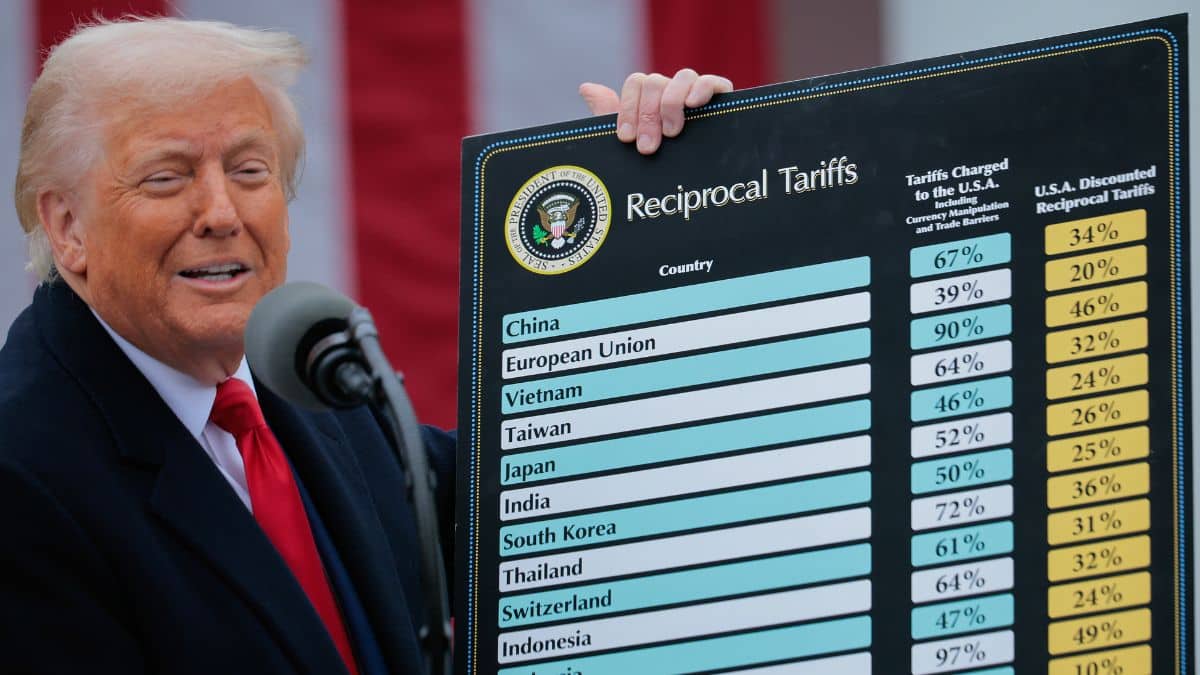Trump Imposes 34% Tariff on Chinese Goods, 10% Global Minimum

On Tuesday, President Donald Trump announced sweeping double-digit tariffs on imports from all countries, starting at a minimum threshold of 10 percent.
The administration released a table of rates that it has calculated for 50 different foreign nations' tariffs on American goods, including the equivalent impact of non-tariff trade barriers. In a press conference Wednesday, Trump said that the U.S. would impose a tariff equal to half of each nation's rate on U.S. goods, as a "kind" discounted reciprocal charge.
The nations facing the steepest U.S. tariff hikes are developing countries in the Indo-Pacific, including Cambodia (49 percent), Laos, Madagascar, Vietnam, Myanmar, Sri Lanka and Thailand (36 percent). Vietnam and Thailand have relevance for American industry, as they have become hubs for Chinese manufacturers looking to source inexpensive labor and evade American tariffs. Cambodia and Sri Lanka have booming garment industries, supplying the U.S. market with low-cost clothing; garment and textile manufacturing accounts for more than half of impoverished Sri Lanka's exports.
Chinese goods will be subject to a rate of 34 percent, higher than many analysts predicted. The new tariff stacks on top of a previously-declared 20 percent rate, so it will bump the net rate on Chinese goods to a total of 54 percent.
Taiwan - which supplies almost all advanced semiconductors to the U.S. market - will be subject to a rate of 32 percent, with immediate effects on technology imports. European goods will be subject to a flat 20 percent rate for all member states, from Hungary to Germany.
| Country | Effective tariff on U.S. goods | U.S.A. Reciprocal Tariffs |
| Cambodia | 97% | 49% |
| Laos | 95% | 48% |
| Madagascar | 93% | 47% |
| Vietnam | 90% | 46% |
| Myanmar (Burma) | 88% | 44% |
| Sri Lanka | 88% | 44% |
| Serbia | 74% | 37% |
| Botswana | 74% | 37% |
| Bangladesh | 74% | 37% |
| Thailand | 72% | 36% |
| China | 67% | 34% |
| Taiwan | 64% | 32% |
| Indonesia | 64% | 32% |
| Switzerland | 61% | 31% |
| South Africa | 60% | 30% |
| Pakistan | 58% | 29% |
| Tunisia | 55% | 28% |
| Kazakhstan | 54% | 27% |
| India | 52% | 26% |
| South Korea | 50% | 25% |
| Japan | 46% | 24% |
| Malaysia | 47% | 24% |
| Côte d'Ivoire | 41% | 21% |
| Jordan | 40% | 20% |
| European Union | 39% | 20% |
| Nicaragua | 36% | 18% |
| Israel | 33% | 17% |
| Philippines | 34% | 17% |
| Norway | 30% | 15% |
| Peru | 10% | 10% |
| Costa Rica | 17% | 10% |
| Dominican Republic | 10% | 10% |
| UAE | 10% | 10% |
| New Zealand | 20% | 10% |
| Argentina | 10% | 10% |
| Ecuador | 12% | 10% |
| Guatemala | 10% | 10% |
| Honduras | 10% | 10% |
| Egypt | 10% | 10% |
| Saudi Arabia | 10% | 10% |
| El Salvador | 10% | 10% |
| Trinidad and Tobago | 12% | 10% |
| Morocco | 10% | 10% |
| United Kingdom | 10% | 10% |
| Brazil | 10% | 10% |
| Singapore | 10% | 10% |
| Chile | 10% | 10% |
| Australia | 10% | 10% |
| Turkey | 10% | 10% |
| Colombia | 10% | 10% |
Courtesy of The White House
Canada and Mexico will be treated separately from the rest of the global list, and are still subject to previously-announced 25 percent tariffs, according to the Wall Street Journal. A separate new tariff of 25 percent on all foreign-built autos takes effect immediately, with repercussions for ro/ro carriers.
Some previously-announced national security tariffs will remain outside of the new rate schedule. This includes the administration's 25 percent tariff on foreign steel and aluminum.
The new tariffs take full effect on April 9, giving time for bilateral negotiations with affected states. "The silver lining for investors could be that this is only a starting point for negotiations with other countries and ultimately tariff rates will come down across the board," Northlight Asset Management chief investment officer Chris Zaccarelli told the Wall Street Journal.
The Dow, Nasdaq and S&P 500 all fell in after-hours trading, reflecting investor concerns that the president's tariffs were steeper than expected. Firms most exposed to consumer imports - like Amazon, down 6.5 percent - dropped the most.
Source: The Maritime Executive
- 4/3/2025
- Shipping News

